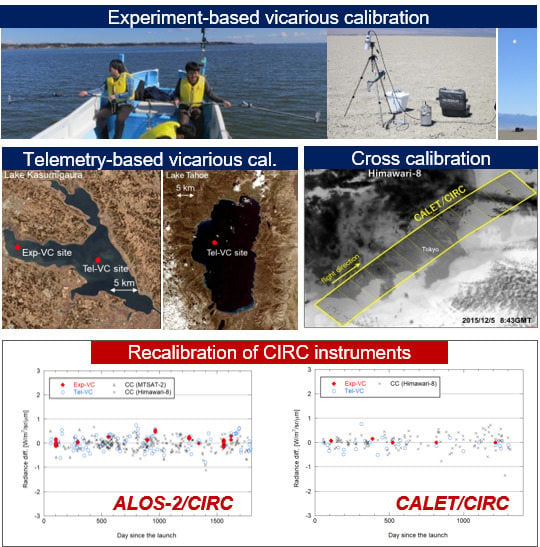In-Flight Radiometric Calibration of Compact Infrared Camera (CIRC) Instruments Onboard ALOS-2 Satellite and International Space Station
Abstract
1. Introduction
2. Materials and Methods
2.1. Compact Infrared Camera (CIRC)
2.1.1. Overview of the CIRC Instrument
2.1.2. Radiometric Processing for CIRC Images
2.2. Experiment-Based Vicarious Calibration
2.2.1. Theoretical Basis
2.2.2. Test Sites
2.2.3. VC Experiments for Each CIRC Instrument
2.2.4. Estimation of TOA Radiance
- By inputting the spectral emissivity, the atmospheric data, the RSR function of the single-band radiometer, and the geometric condition of the single-band radiometer measurement (nadir viewing at an altitude of 2 m) into MODTRAN, the observed radiance of the single-band radiometer was iteratively calculated under a provisional value of the surface kinetic temperature. The surface kinetic temperature which represented the best match between the calculated radiance and the actual radiance measured by the single-band radiometer was selected as the true surface kinetic temperature.
- By inputting the obtained surface kinetic temperature, the spectral emissivity, the atmospheric data, the RSR function of the CIRC instrument, and the geometric condition of the CIRC measurement to MODTRAN, the observed radiance of the targeted CIRC instrument was calculated.
2.3. Telemetry-Based Vicarious Calibration
2.3.1. Overview
2.3.2. Tel-VC Analyses for Each CIRC Instrument
2.4. Cross-Calibration Using Geostationary Satellite Sensors
2.4.1. Overview
2.4.2. Viewing Angle Correction
2.4.3. Generation of GS-Based CIRC Image
- An AIRS image acquired over the CIRC-covered area within one day from the CIRC observation date was searched and downloaded.
- All AIRS pixels (including clouds) with a scan angle within 15 degrees from the CIRC viewing angle were selected.
- For each AIRS pixel selected, each radiance of the CIRC instrument and the GS sensor bands was calculated by convolution with each RSR function.
- The linear regression equation for estimating the CIRC radiance from the radiances of the GS sensor bands was calculated using all radiance data obtained in Step 4.
2.4.4. Co-Registration with Parallax Correction
2.4.5. Statistical Screening
2.5. Determination of Recalibration Coefficients for the CIRC Instruments
3. Results and Discussion
3.1. Sensitivity Analysis Results for Exp-VC and Tel-VC
3.2. Coefficients and RMS Errors of AIRS-Based Regression Equations Used in CC
3.3. Results for ALOS-2/CIRC
3.4. Results for CALET/CIRC
4. Summary and Conclusions
Author Contributions
Funding
Acknowledgments
Conflicts of Interest
References
- Kato, E.; Katayama, H.; Naitoh, M.; Harada, M.; Nakamura, R.; Nakau, K.; Sato, R. Compact infrared camera (CIRC) for earth observation adapting athermal optics. Proc. SPIE 2013, 8860, 88600C. [Google Scholar]
- Suzuki, S.; Osawa, Y.; Hatooka, Y.; Kankaku, Y.; Watanabe, T. Overview of Japan’s Advanced Land Observing Satellite-2 Mission. Proc. SPIE 2009, 7474, 74740Q-1. [Google Scholar]
- Marrocchesi, P.S.; CALET Collaboration. CALET on the ISS: a high energy astroparticle physics experiment. J. Phys. Conf. Ser. 2016, 718, 052023. [Google Scholar] [CrossRef]
- CIRC Observation Data Search. Available online: http://circgs.tksc.jaxa.jp/data/ (accessed on 20 November 2019).
- Volcano Monitoring System (under Research). Available online: https://kazan.jaxa.jp/ (accessed on 20 November 2019).
- Yamaguchi, Y.; Kahle, A.B.; Tsu, H.; Kawakami, T.; Pniel, M. Overview of the Advanced Spaceborne Thermal Emission and Reflectance Radiometer (ASTER). IEEE Trans. Geosci. Remote Sens. 1998, 36, 1062–1071. [Google Scholar] [CrossRef]
- Guenther, B.; Barnes, W.; Knight, E.; Barder, J.; Harnden, J.; Weber, R.; Roberto, M.; Godden, G.; Montgomery, H.; Abel, P. MODIS calibration: A brief review of the strategy for the at-launch calibration approach. J. Atmos. Ocean. Technol. 1996, 13, 274–285. [Google Scholar] [CrossRef]
- Kato, E.; Katayama, H.; Naitoh, M.; Harada, M.; Nakamura, R.; Sakai, M.; Nakajima, Y.; Nakau, K.; Tange, Y.; Sato, R. Radiometric calibration of Compact Infrared Camera (CIRC) for earth observation. Sens. Mater. 2014, 26, 199–214. [Google Scholar]
- Tonooka, H.; Palluconi, F.D.; Hook, S.J.; Matsunaga, T. Vicarious calibration of ASTER thermal infrared bands. IEEE Trans. Geosci. Remote Sens. 2005, 43, 2733–2746. [Google Scholar] [CrossRef]
- Tang, H.; Li, Z.L. (Eds.) Quantitative Remote Sensing in Thermal Infrared: Theory and Applications. In Springer Remote Sensing/Photogrammetry; Springer: Berlin, Germany, 2014. [Google Scholar]
- CEOS LandNet Sites—CalValPortal. Available online: http://calvalportal.ceos.org/ceos-landnet-sites (accessed on 20 November 2019).
- Baldridge, A.M.; Hook, S.J.; Grove, C.I.; Rivera, G. The ASTER spectral library version 2.0. Remote Sens. Environ. 2009, 113, 711–715. [Google Scholar] [CrossRef]
- EMC: Data Assimilation Team. Available online: https://www.emc.ncep.noaa.gov/gmb/gdas/ (accessed on 20 November 2019).
- Levelt, P.F.; Oord, G.H.J.; van den Dobber, M.R.; Mälkki, A.; Visser, H.J.; de Vries, J.; Stammes, P.; Lundell, J.O.V.; Saari, H. The ozone monitoring instrument. IEEE Trans. Geosci. Remote Sens. 2006, 44, 1093–1101. [Google Scholar] [CrossRef]
- Berk, A.; Anderson, G.P.; Acharya, P.K.; Bernstein, L.S.; Muratov, L.; Lee, J.; Fox, M.; Adler-Golden, S.M.; Chetwynd, J.H.; Hoke, M.L.; et al. MODTRAN 5: A reformulated atmospheric band model with auxiliary species and practical multiple scattering options: Update. Proc. SPIE 2005, 5806. [Google Scholar] [CrossRef]
- Berk, A.; Anderson, G.; Acharya, P.; Shettle, E. MODTRAN 5.2.0.0 User’s Manual; Spectral Sciences, Inc.: Burlington, MA, USA; Air Force Res. Lab.: Montgomery, OH, USA; Hanscom AFB: Middlesex, MA, USA, 2008. [Google Scholar]
- Kato, S.; Matsunaga, T.; Tonooka, H. Statistical and in-situ validations of the ASTER spectral emissivity product at Railroad Valley, Nevada, USA. Remote Sens. Environ. 2014, 145, 81–92. [Google Scholar] [CrossRef]
- Water Information System. Available online: http://www1.river.go.jp/ (accessed on 20 November 2019).
- Hook, S.; Vaughan, R.; Tonooka, H.; Schladow, S. Absolute radiometric in-flight validation of mid infrared and thermal infrared data from ASTER and MODIS on the Terra spacecraft using the Lake Tahoe, CA/NV, USA, automated validation site. IEEE Trans. Geosci. Remote Sens. 2007, 45, 1798–1807. [Google Scholar] [CrossRef]
- Lake Tahoe Validation. Available online: https://laketahoe.jpl.nasa.gov/ (accessed on 20 November 2019).
- Uesawa, D. Status of Japanese meteorological satellites and recent activities of MSC. In Proceedings of the 2006 Eumesat Meteorological Satellite Conference, Helsinki, Finland, 12–16 June 2006. [Google Scholar]
- Bessho, K.; Date, K.; Hayashi, M.; Ikeda, A.; Imai, T.; Inoue, H.; Kumagai, Y.; Miyakawa, T.; Murata, H.; Ohno, T.; et al. An Introduction to Himawari-8/9―Japan’s New-Generation Geostationary Meteorological Satellites. J. Meteorol. Soc. Jpn. 2016, 94, 151–183. [Google Scholar] [CrossRef]
- Aumann, H.H.; Chahine, M.T.; Gautier, C.; Goldberg, M.D.; Kalnay, E.; McMillin, L.M.; Revercomb, H.; Rosenkranz, P.W.; Smith, W.L.; Staelin, D.H.; et al. AIRS/AMSU/HSB on the Aqua mission: Design, science objectives, data products, and processing systems. IEEE Trans. Geosci. Remote Sens. 2003, 41, 253–264. [Google Scholar] [CrossRef]
- Clerbaux, C.; Boynard, A.; Clarisse, L.; George, M.; Hadji-Lazaro, J.; Herbin, H.; Hurtmans, D.; Pommier, M.; Razavi, A.; Turquety, S.; et al. Monitoring of atmospheric composition using the thermal infrared IASI/MetOp sounder. Atmos. Chem. Phys. 2009, 9, 6041–6054. [Google Scholar] [CrossRef]
- Hewison, T.J.; Wu, X.; Yu, F.; Tahara, Y.; Hu, X.; Kim, D.; Koenig, M. GSICS inter-calibration of infrared channels of geostationary imagers using Metop/IASI. IEEE Trans. Geosci. Remote Sens. 2013, 51, 1056–1080. [Google Scholar] [CrossRef]
- Okuyama, A.; Takahashi, M.; Date, K.; Hosaka, K.; Murata, H.; Tabata, T.; Yoshino, R. Validation of Himawari-8/AHI radiometric calibration based on two years of in-orbit data. J. Meteor. Soc. Jpn. 2018, 96B, 91–109. [Google Scholar] [CrossRef]
- Jiang, G.M.; Li, Z.L. Cross-calibration of MSG1-SEVIRI infrared channels with Terra-MODIS channels. Int. J. Remote Sens. 2009, 30, 753–769. [Google Scholar] [CrossRef]
- USGS EROS Archive—Digital Elevation—Global 30 Arc-Second Elevation (GTOPO30). Available online: https://doi.org/10.5066/F7DF6PQS (accessed on 20 November 2019).
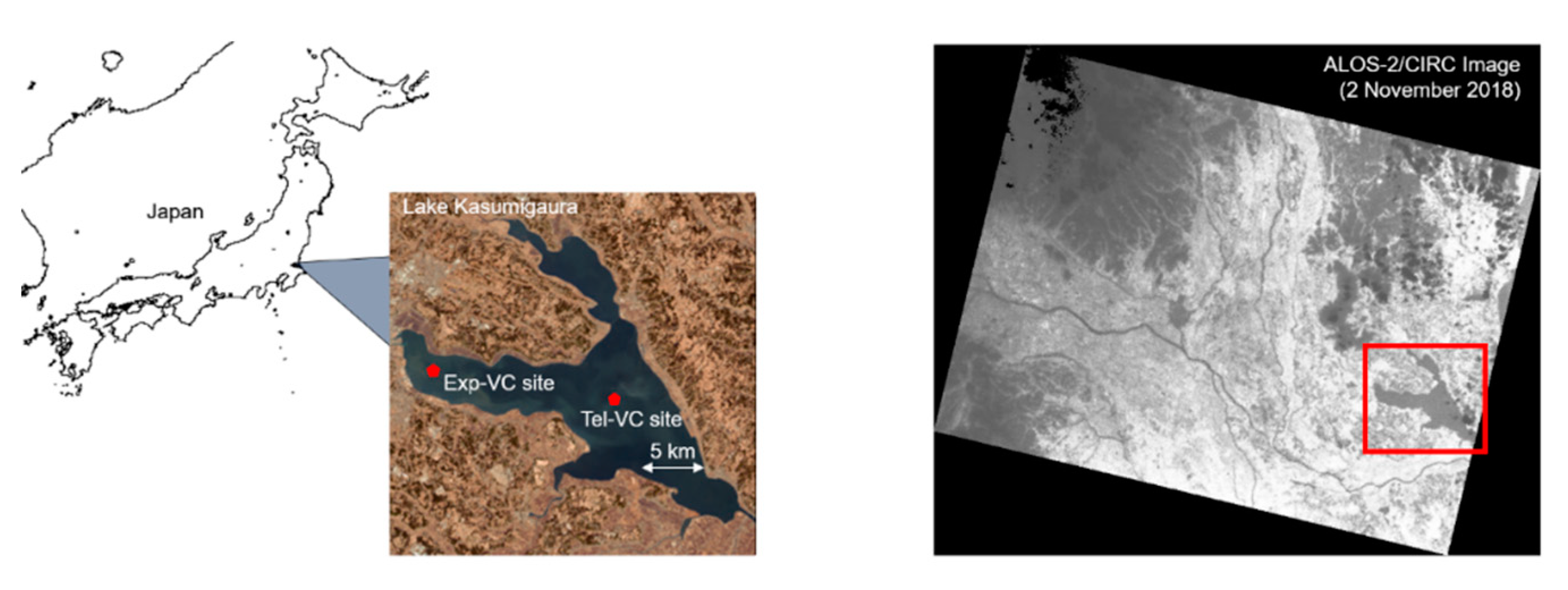
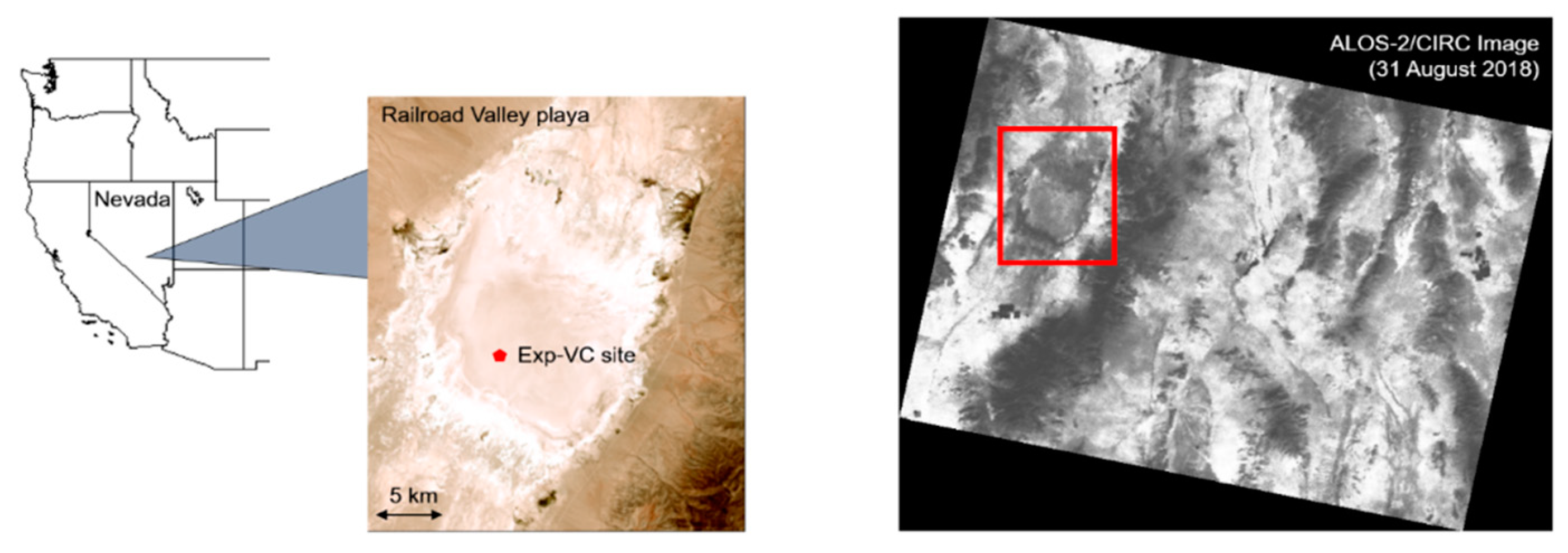
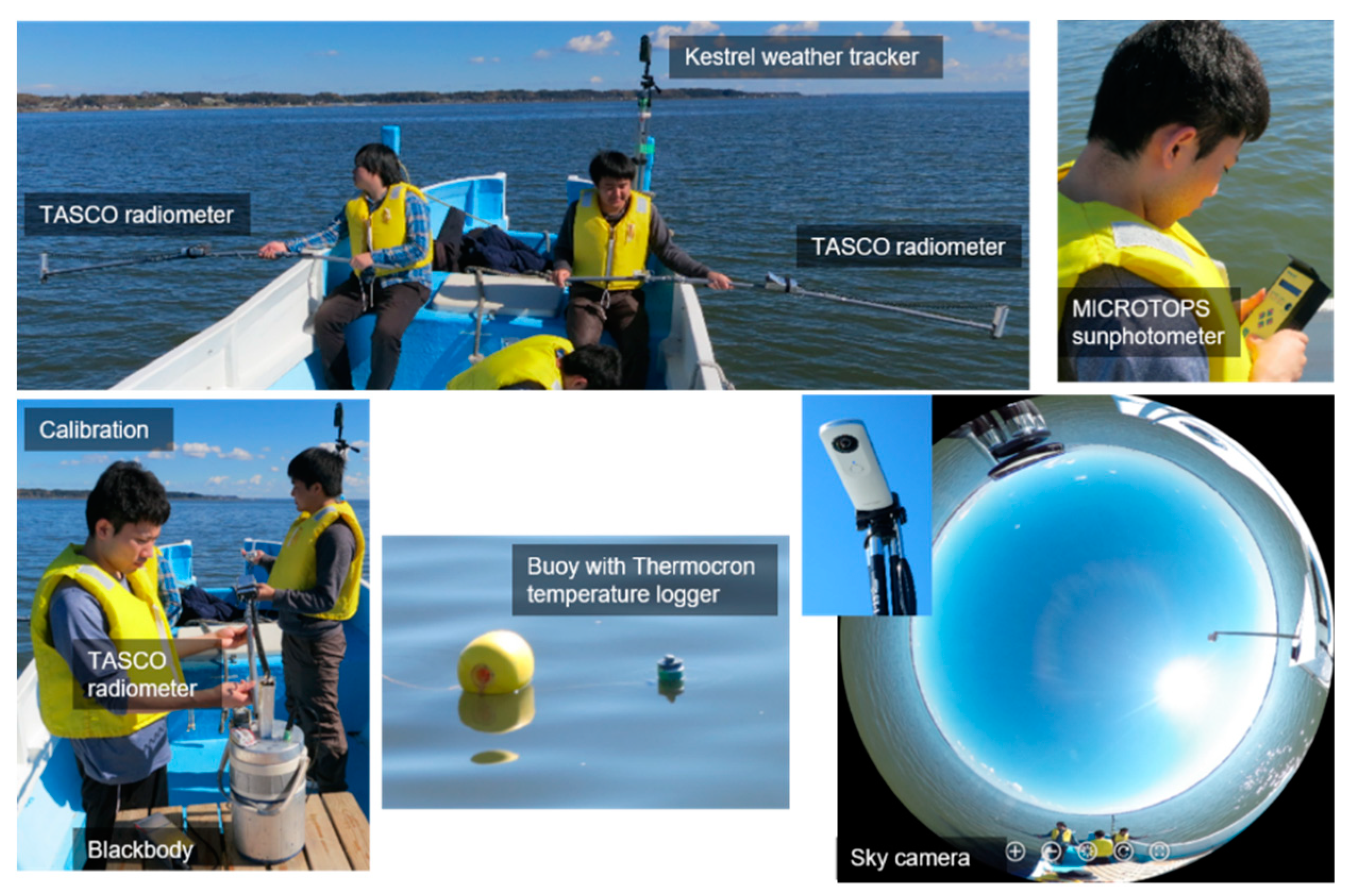
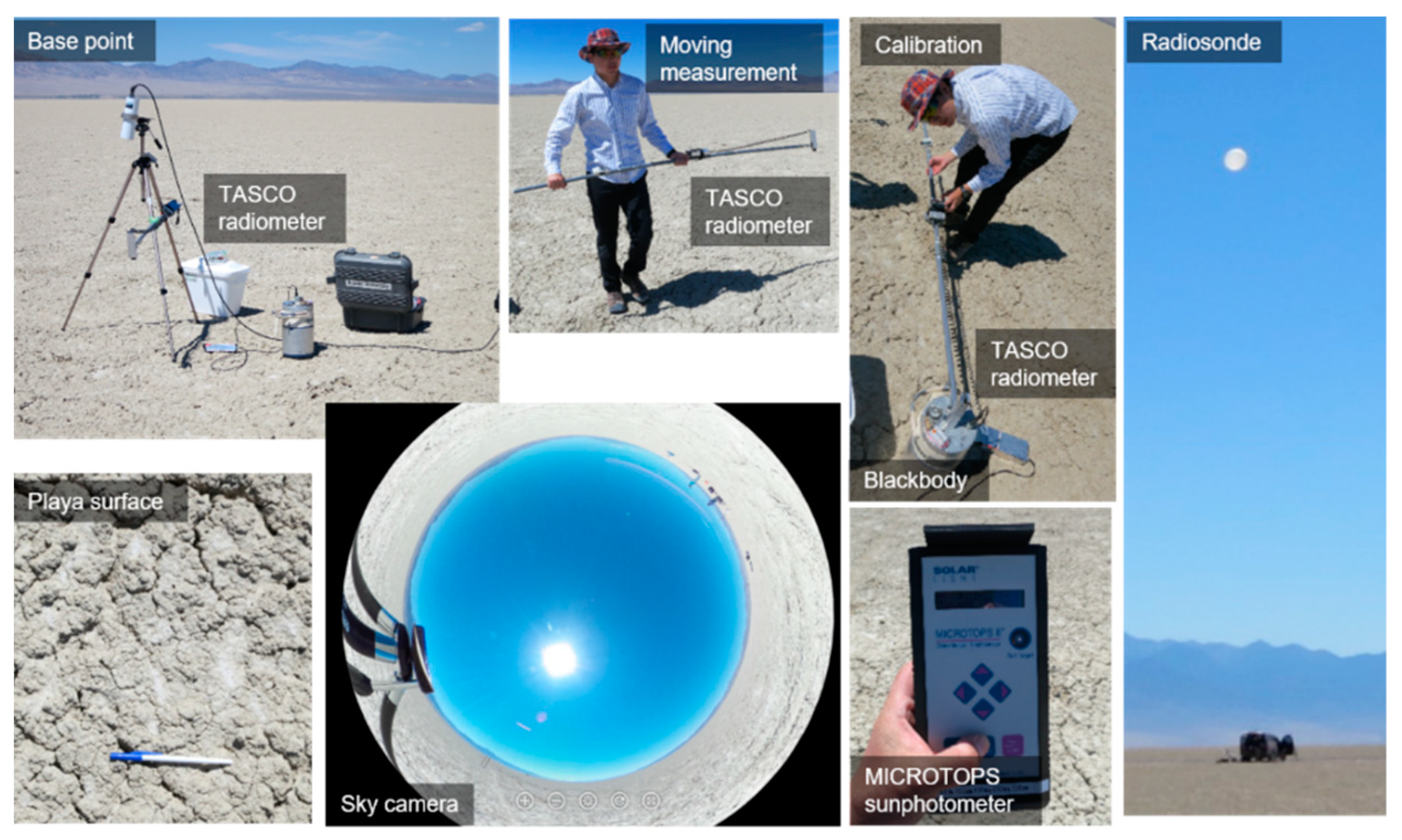
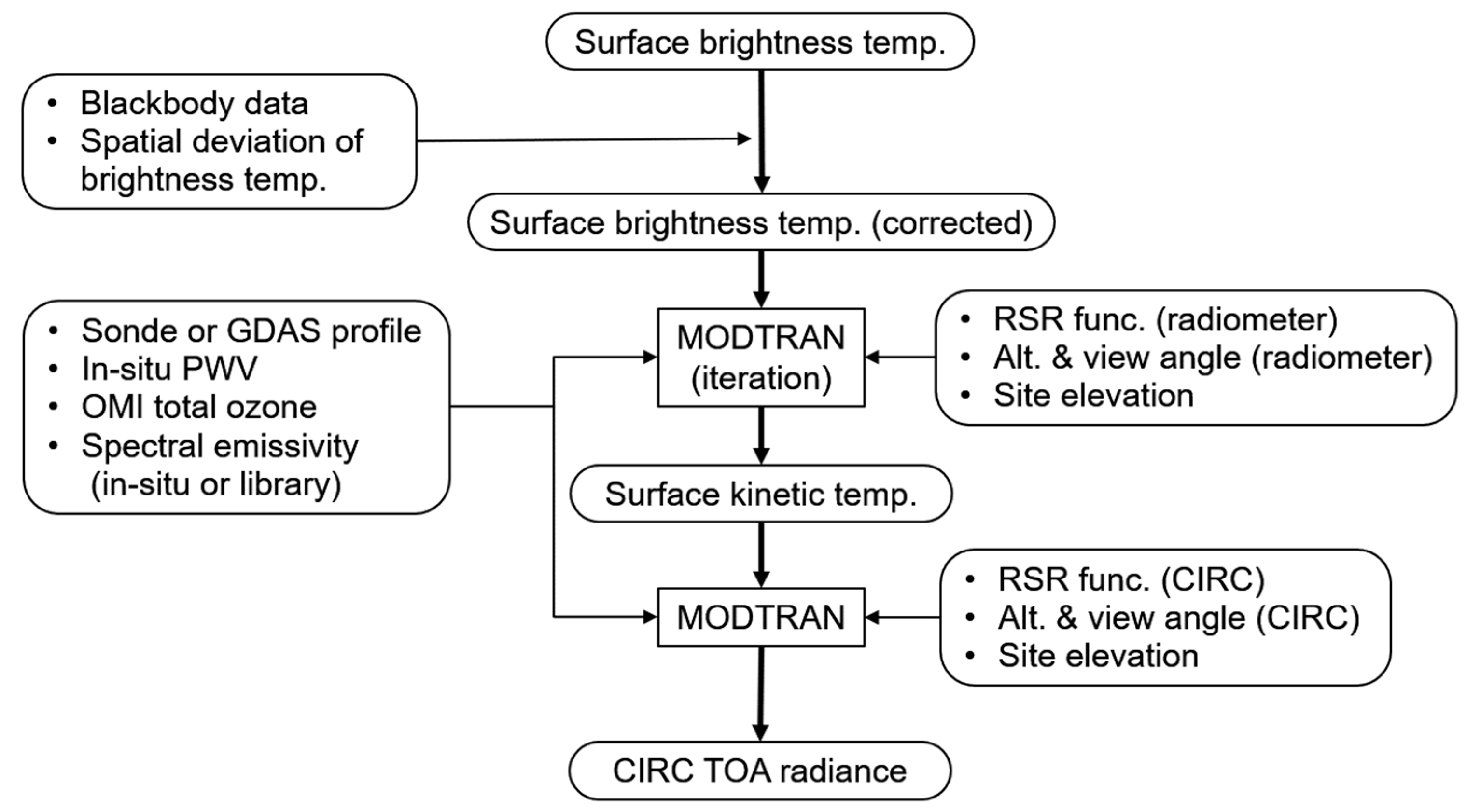
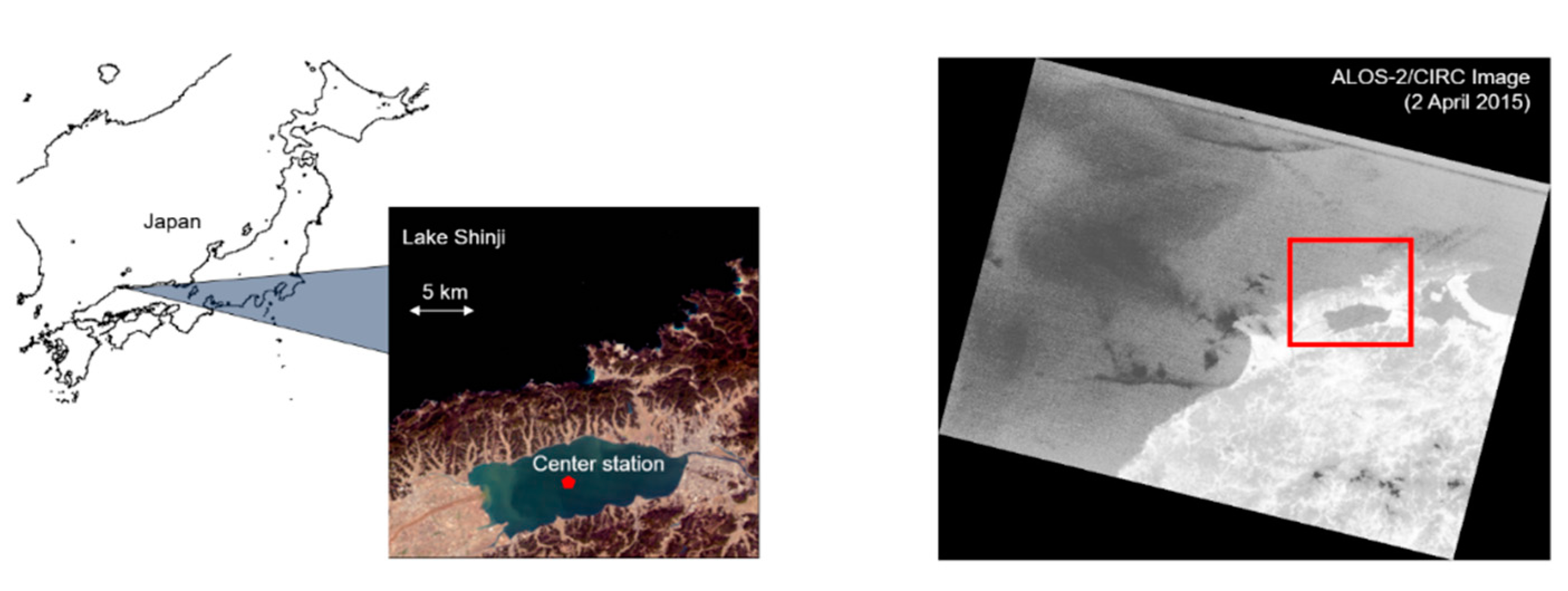
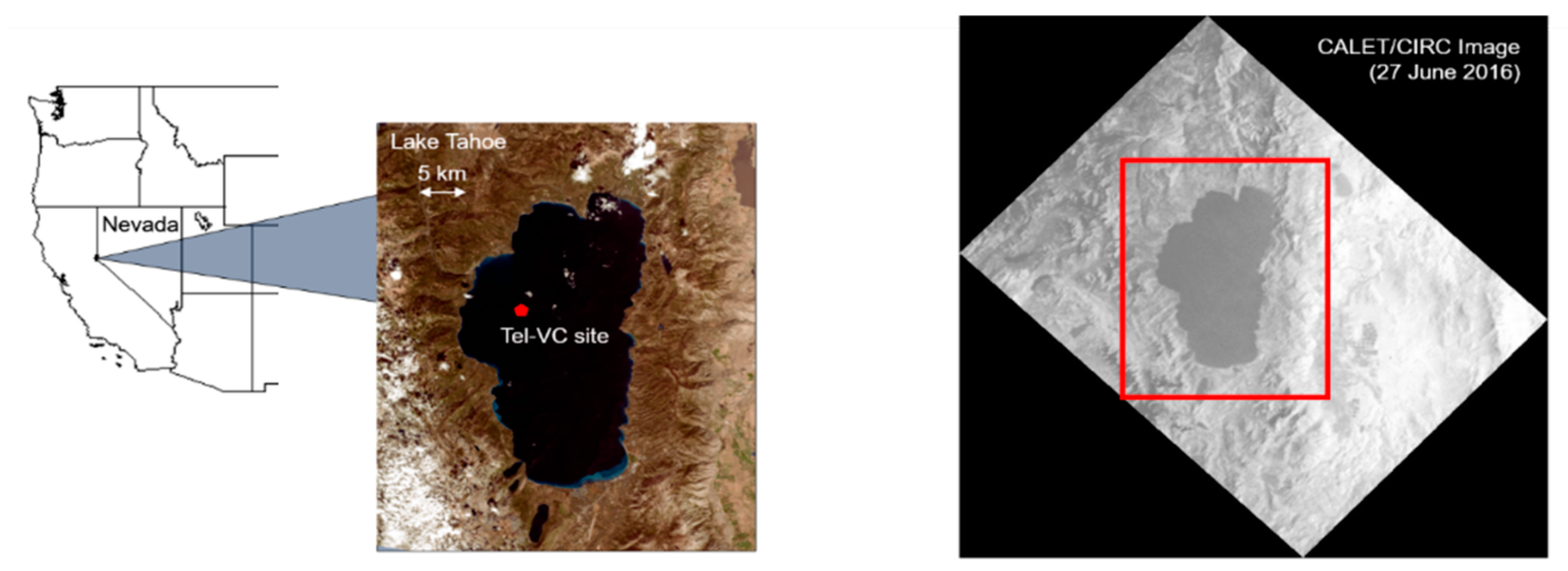
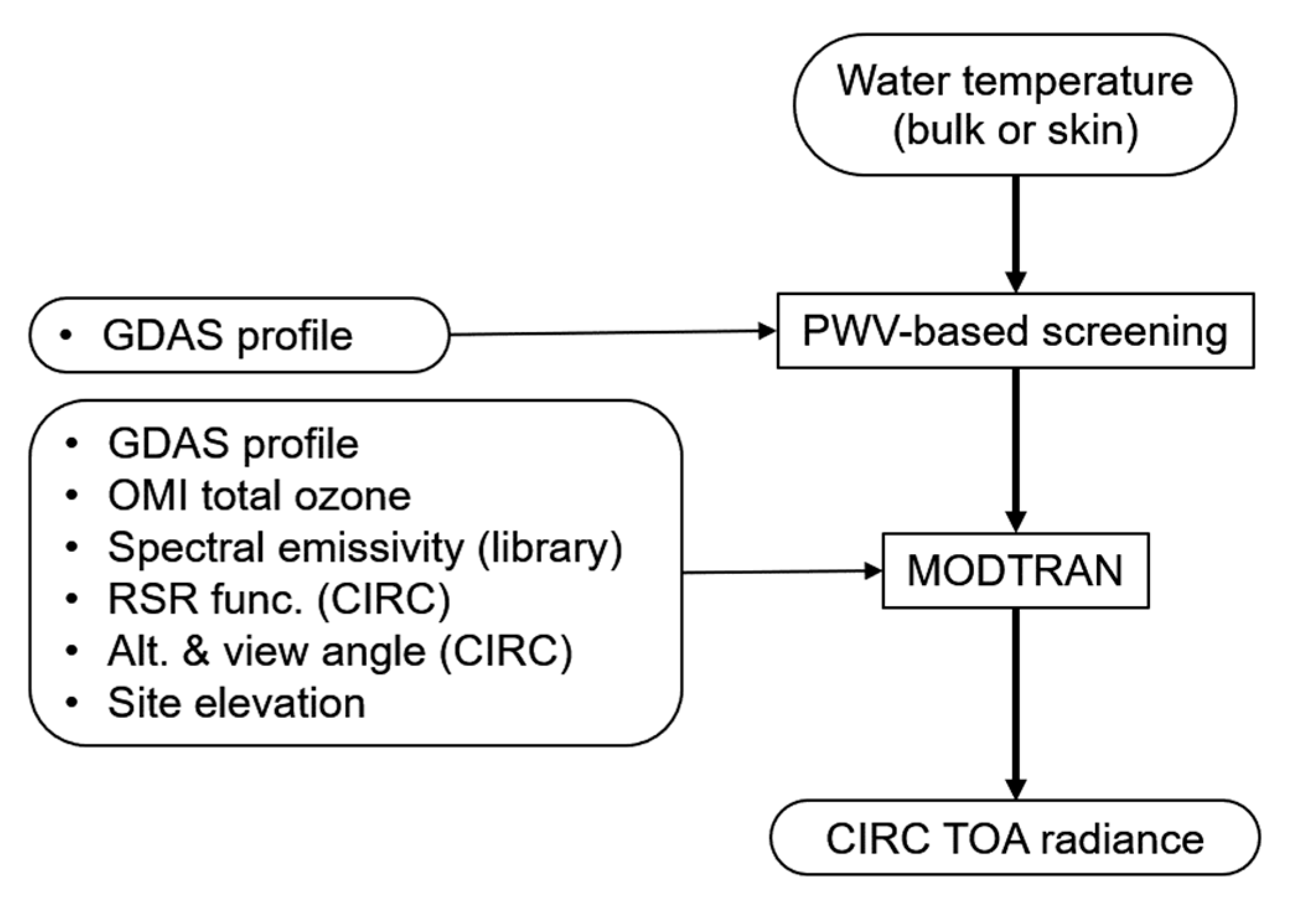
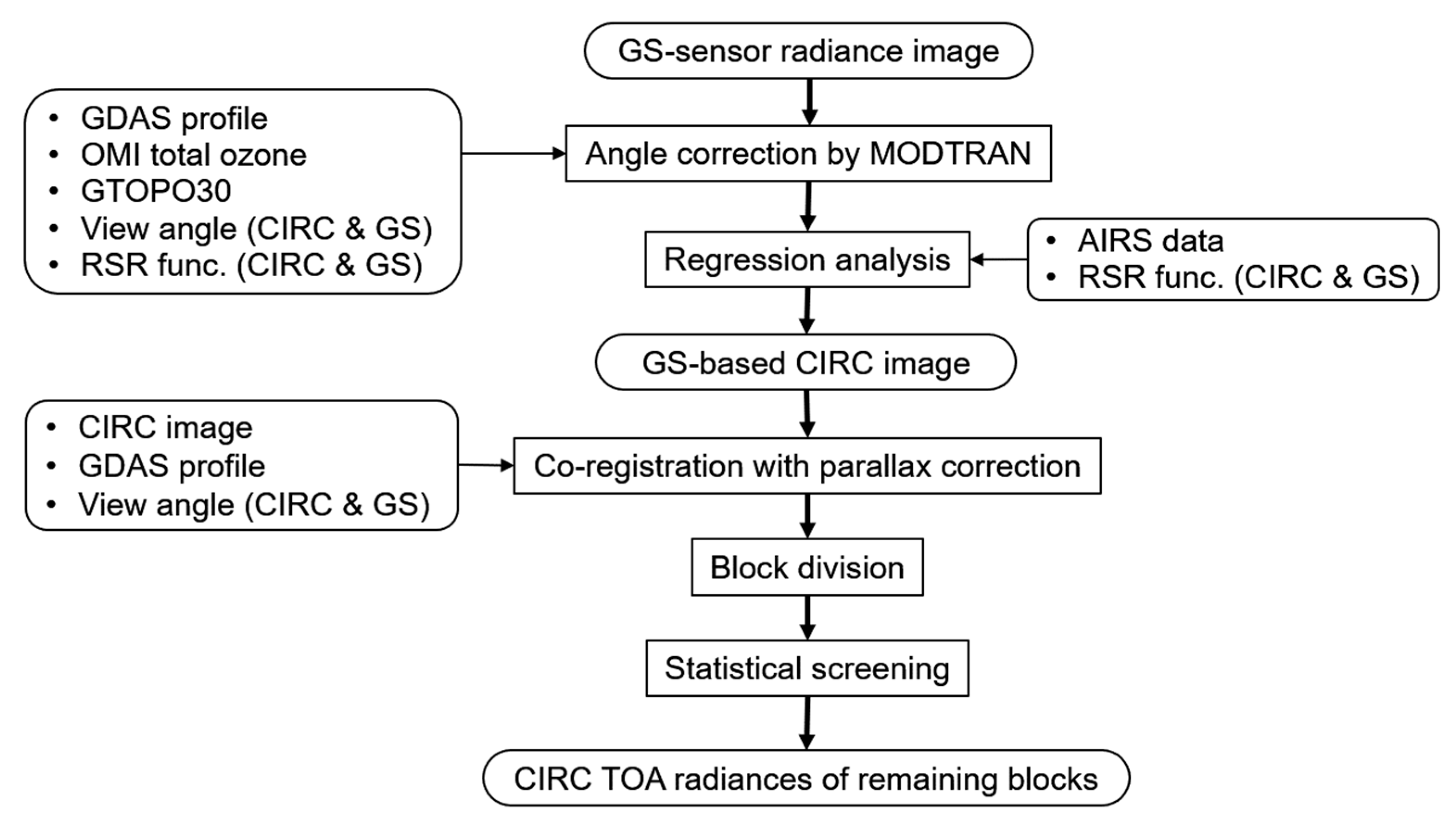

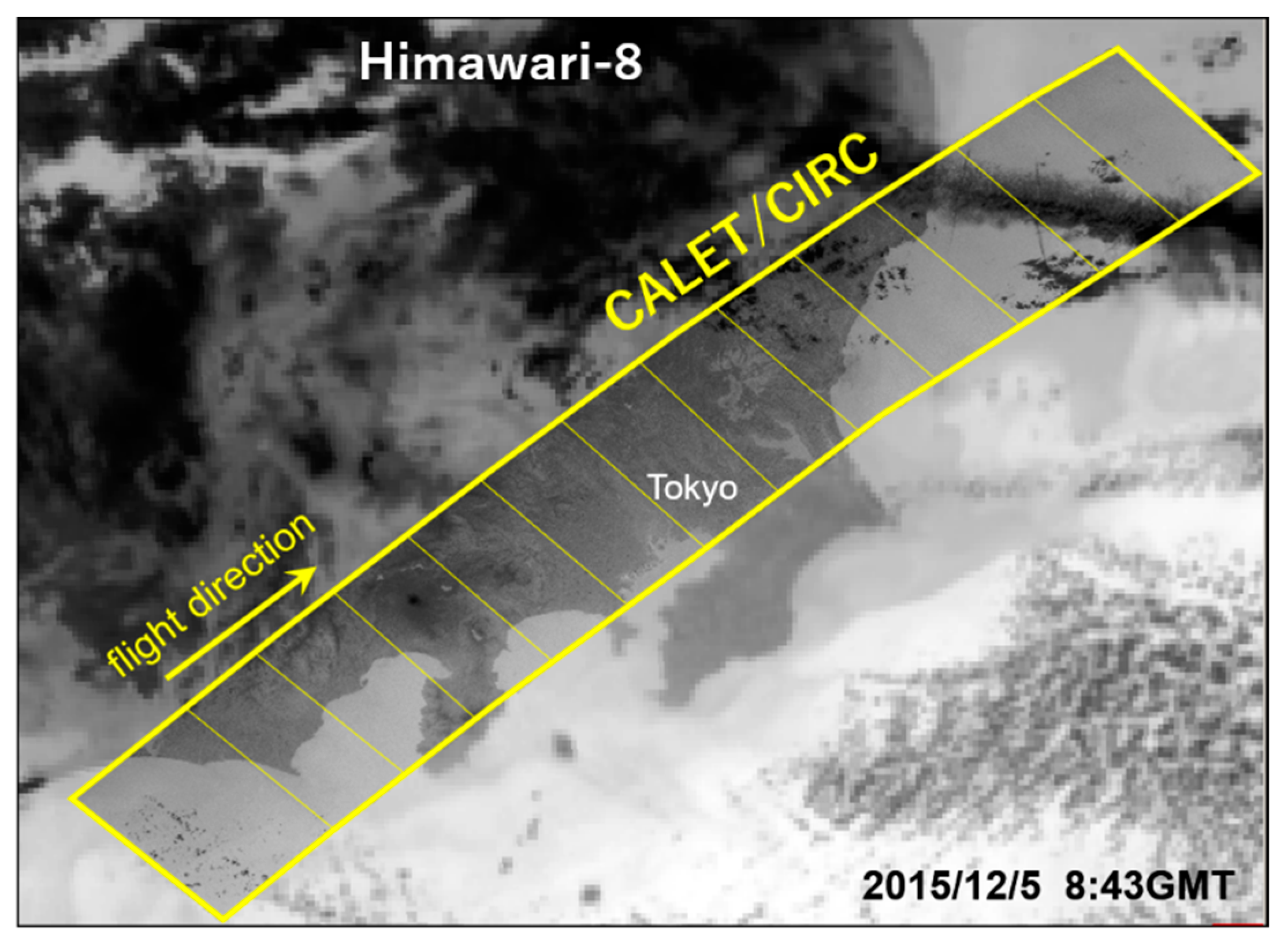
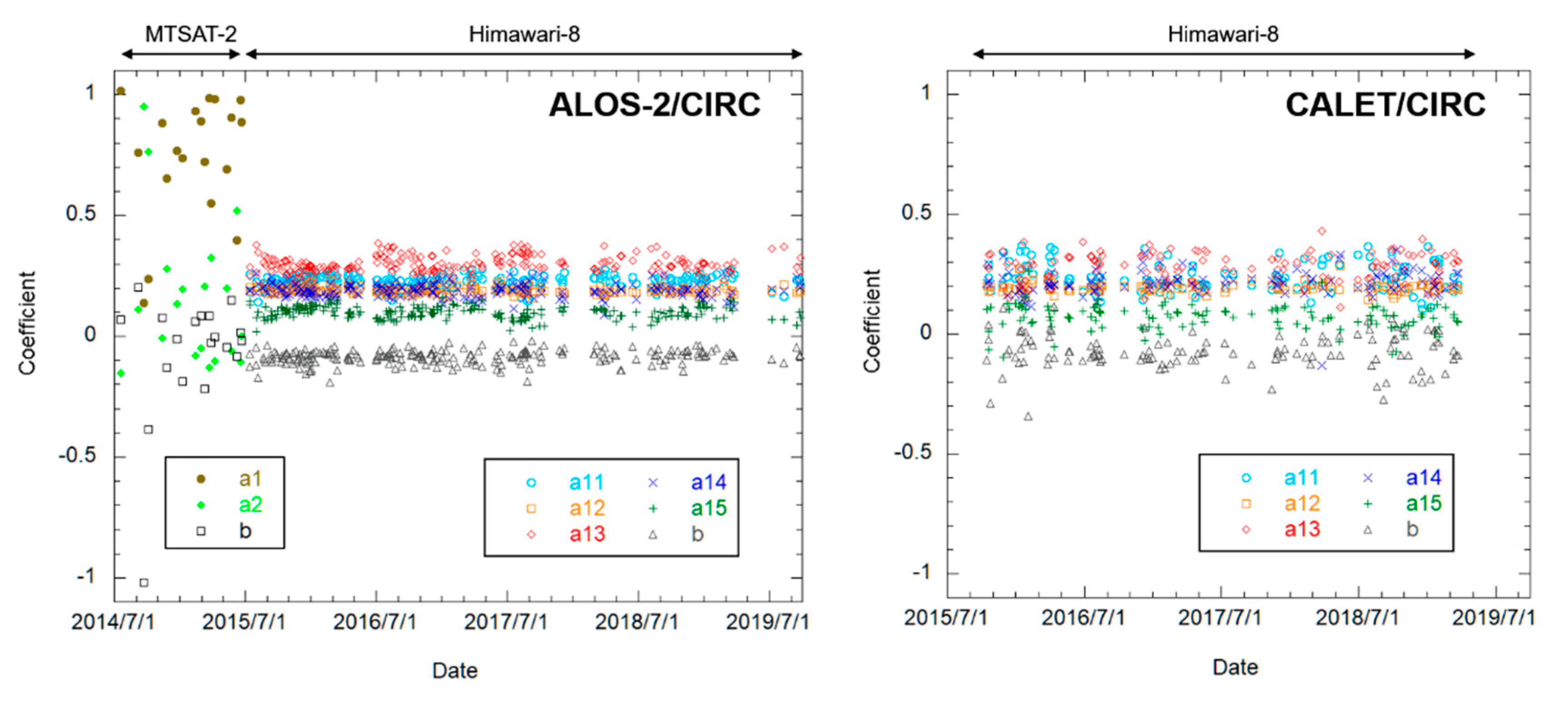
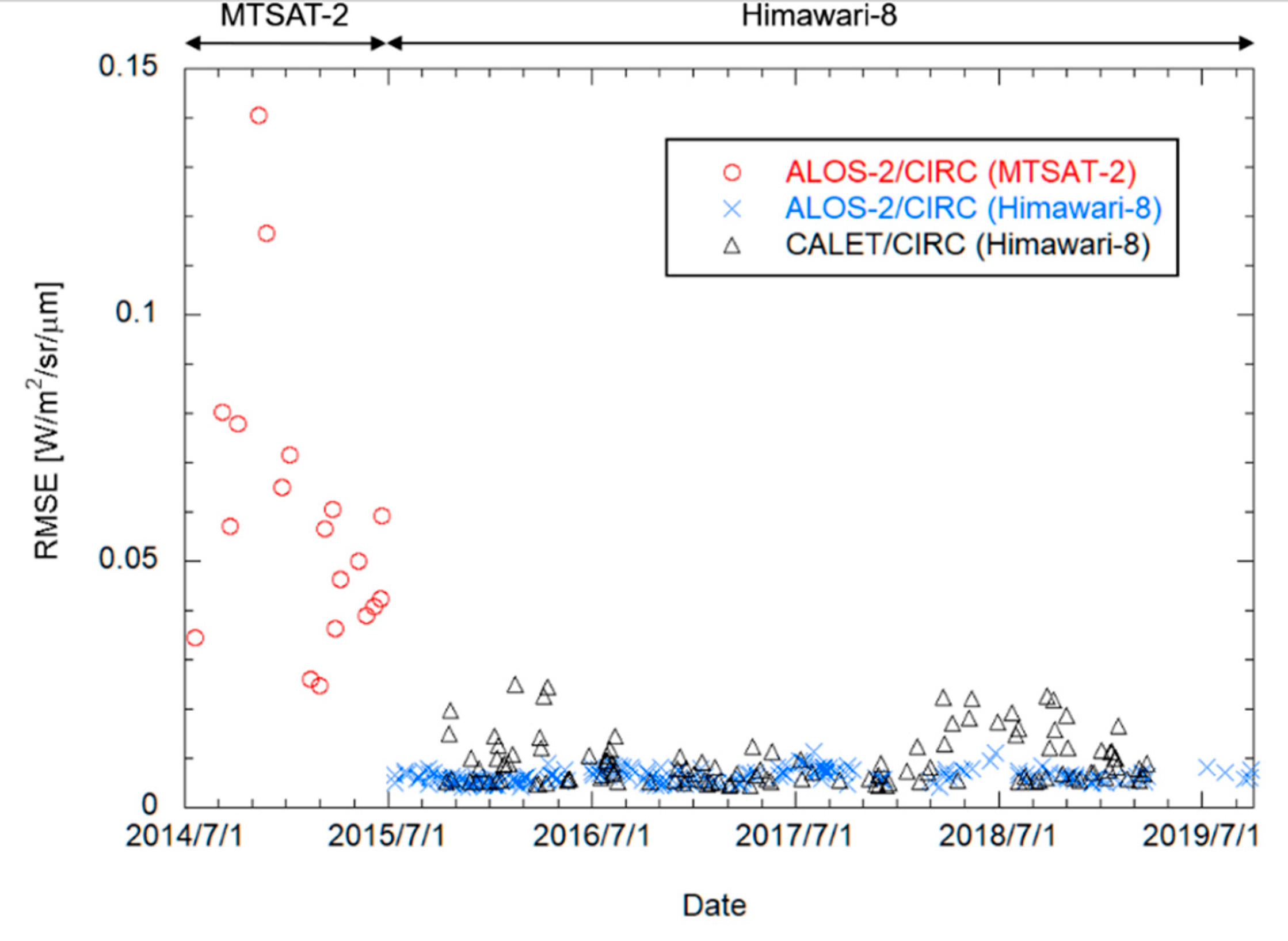
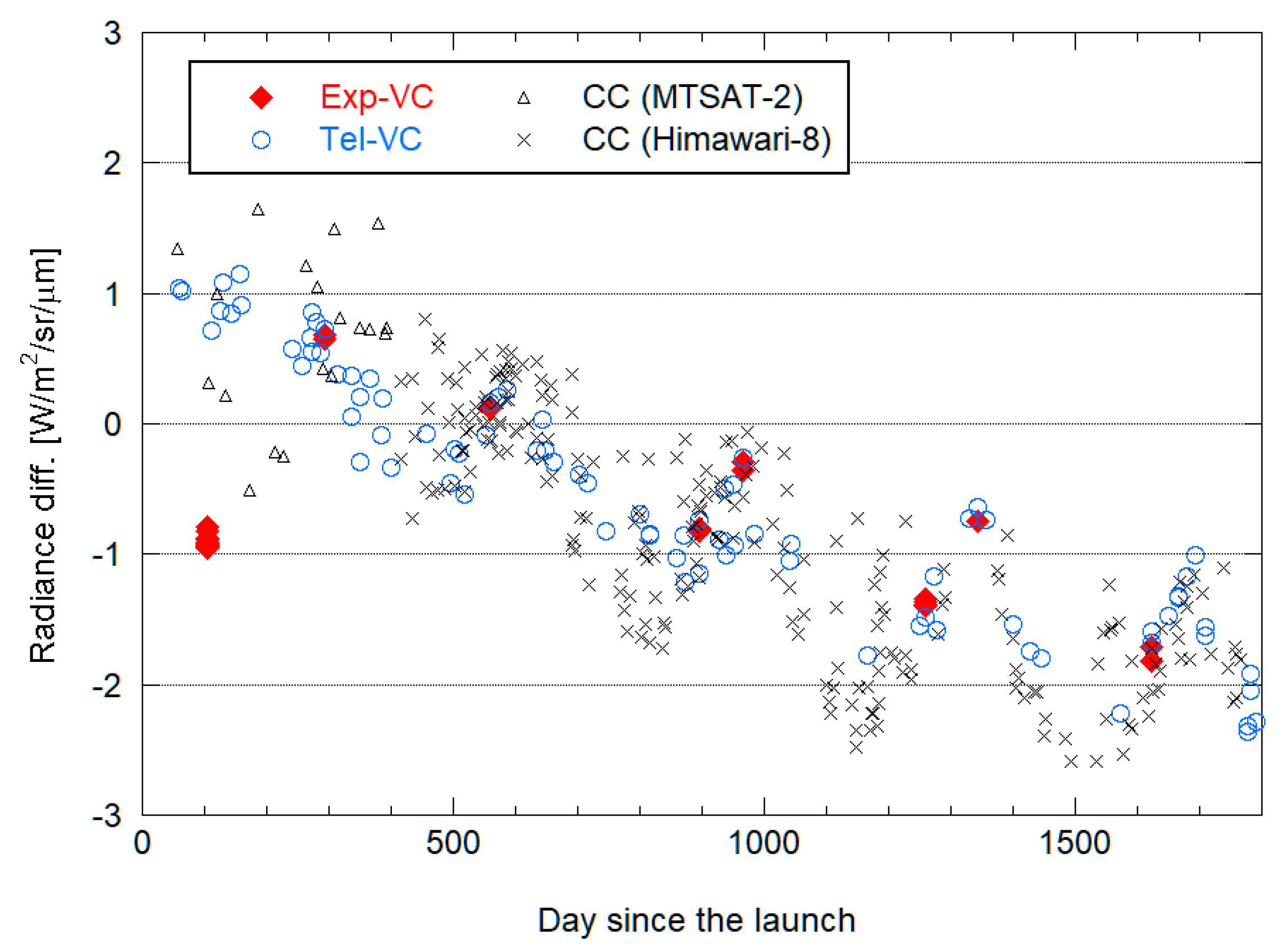
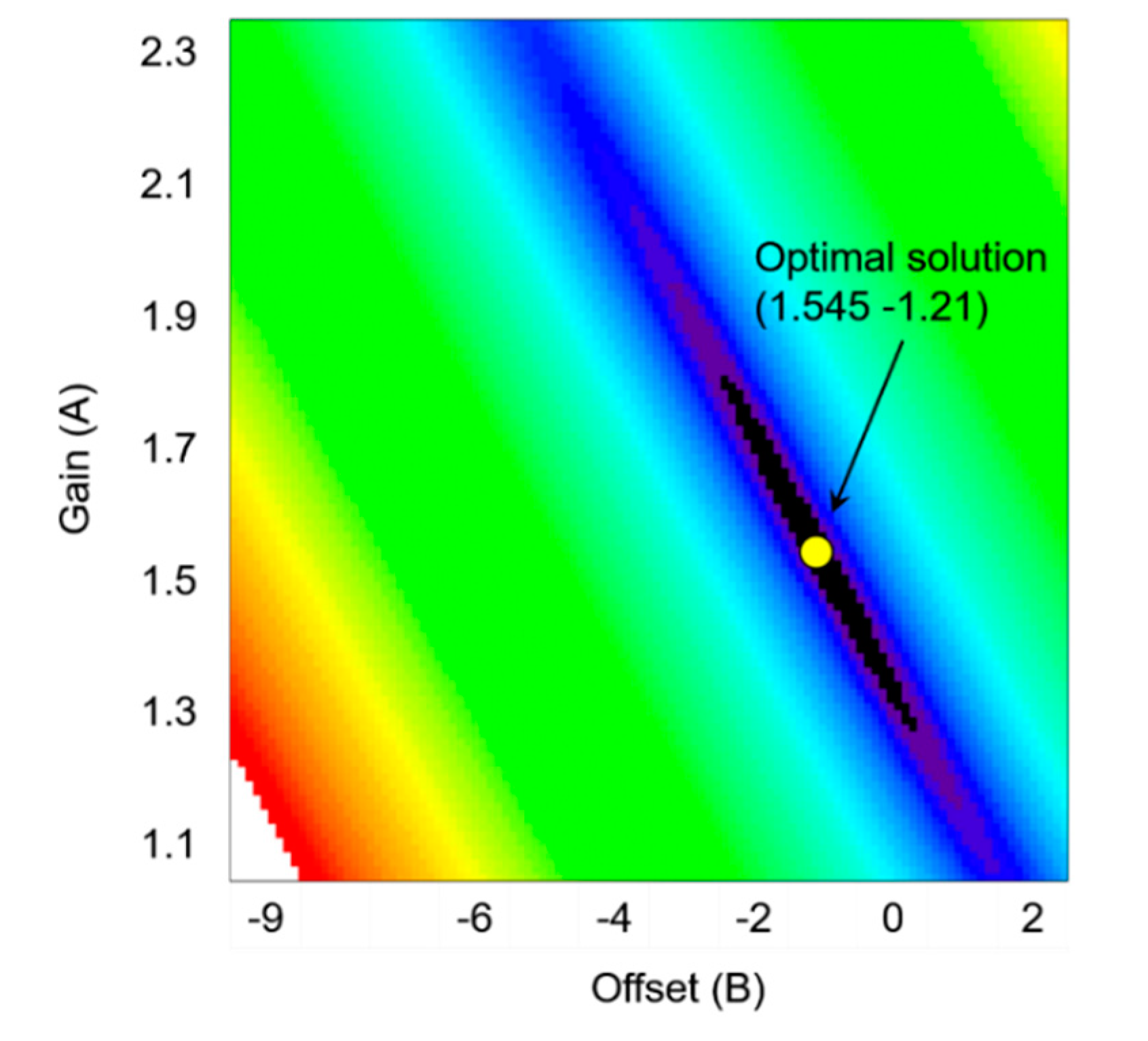
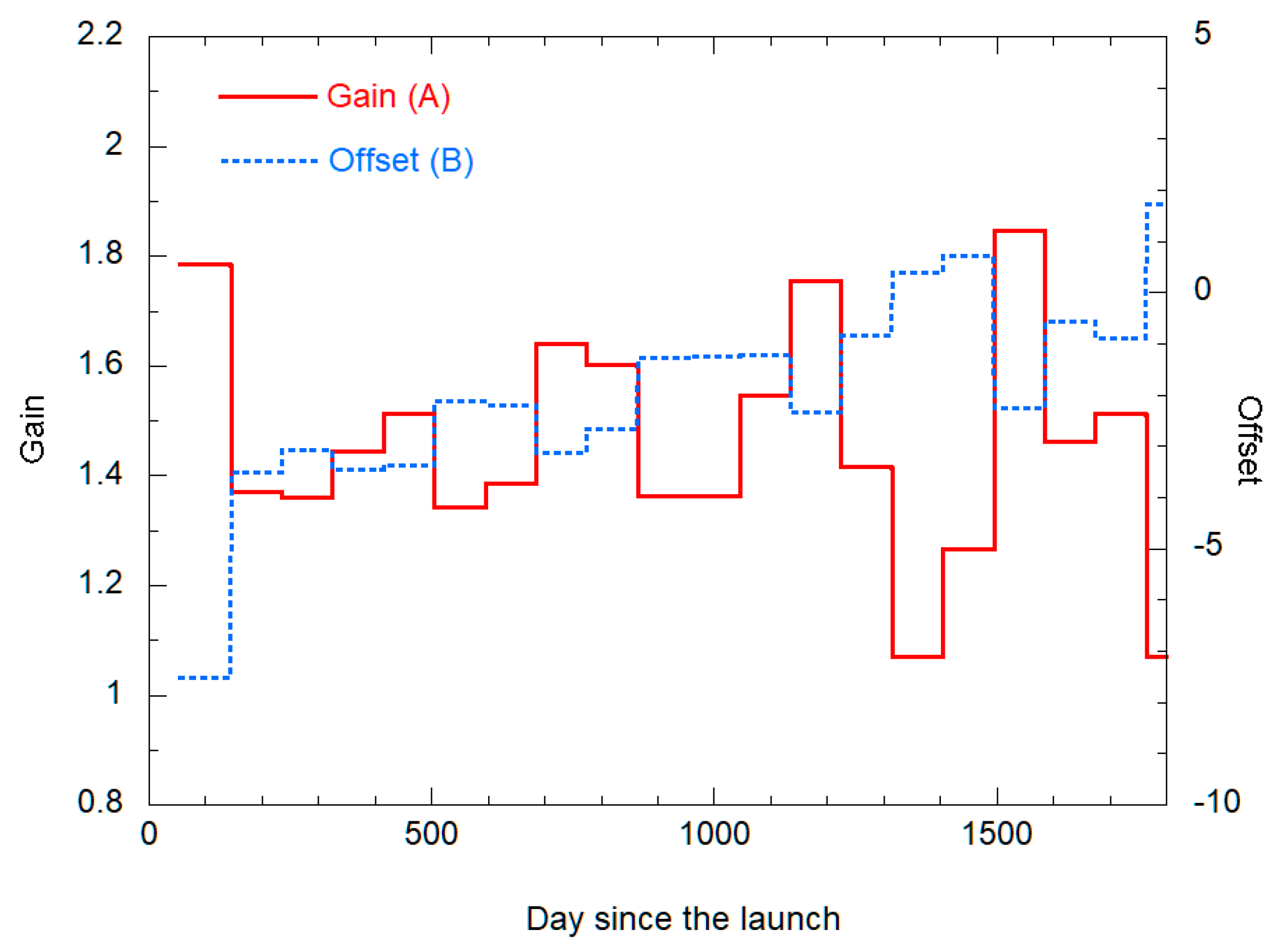
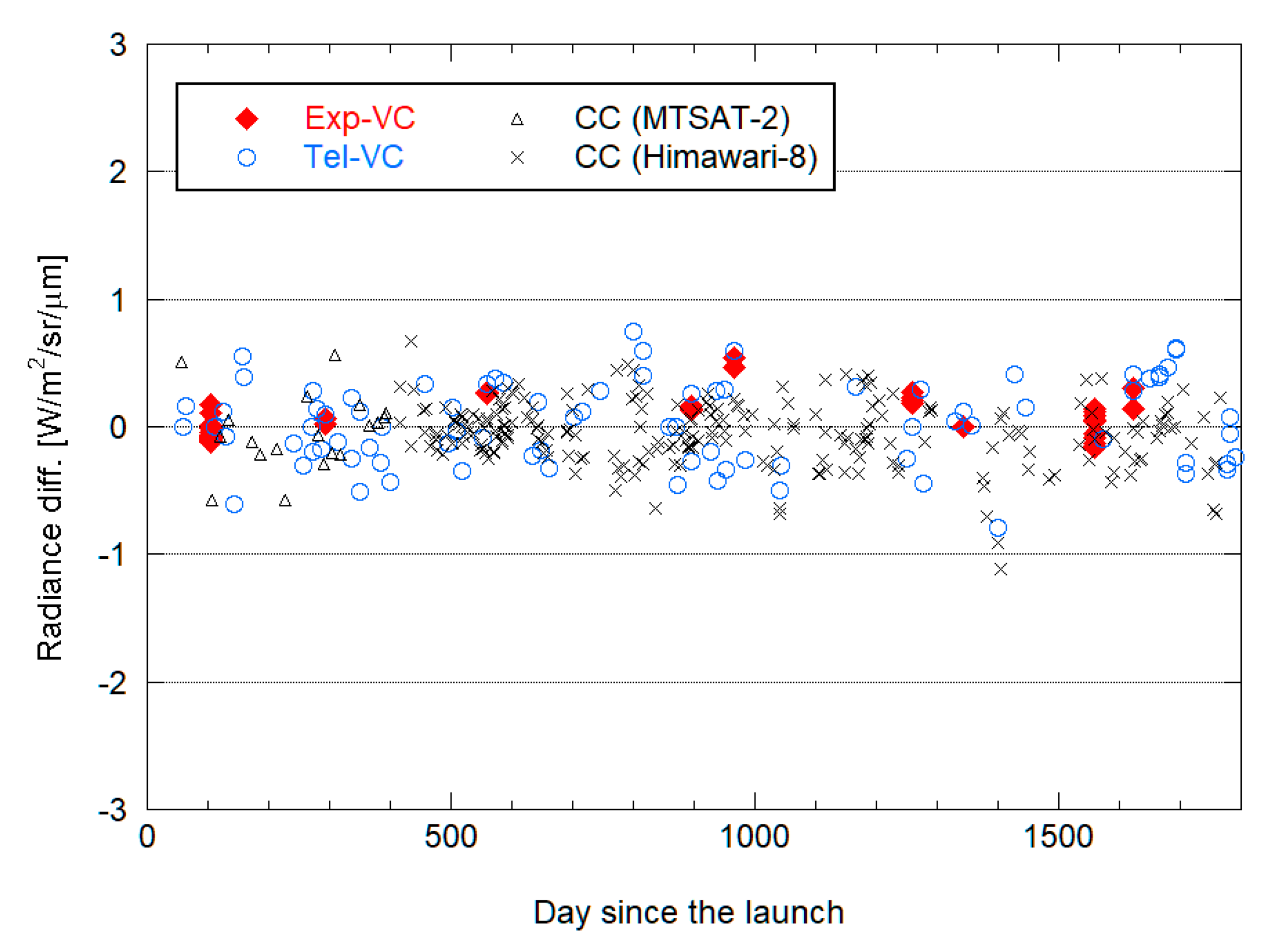
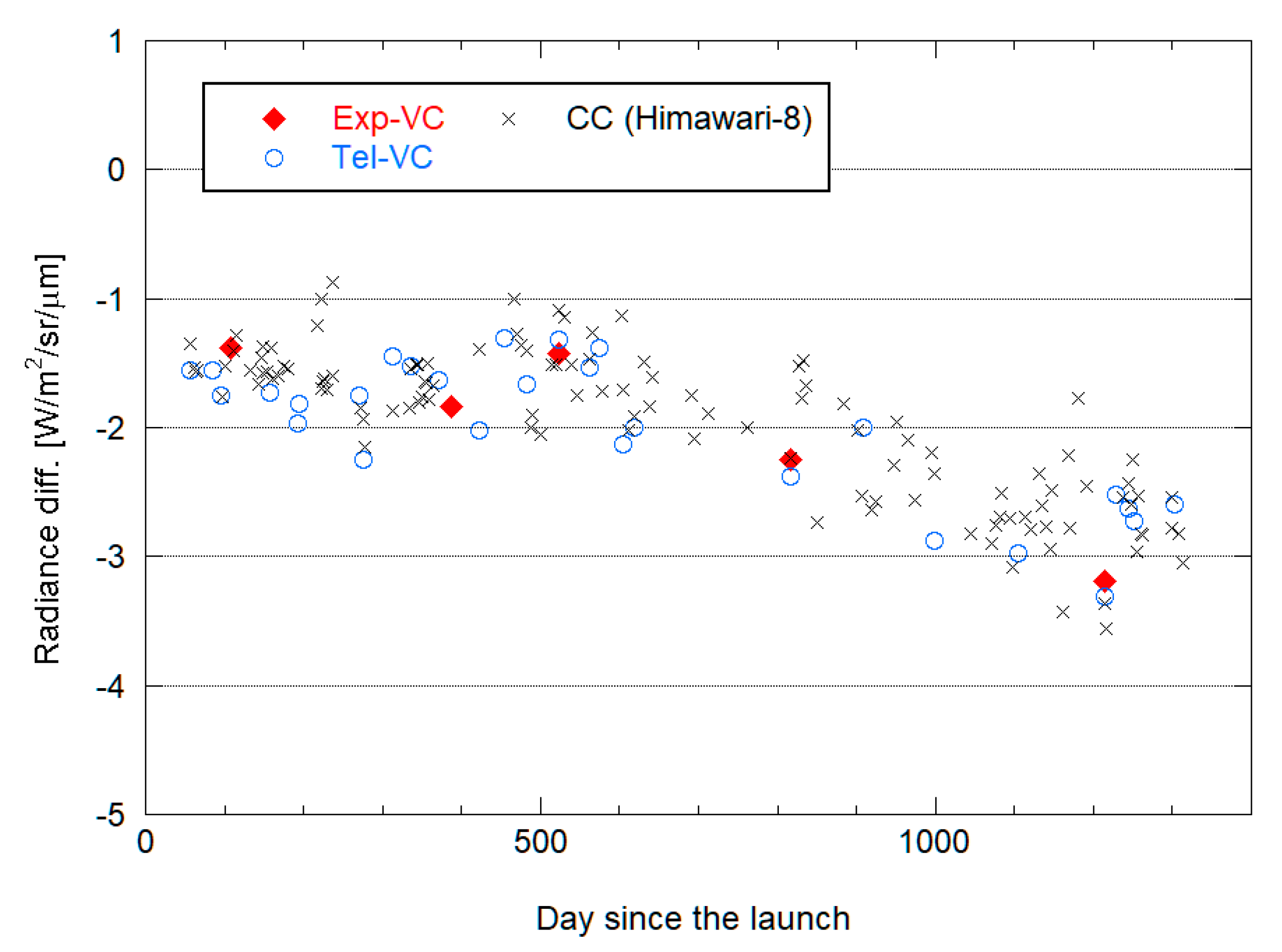
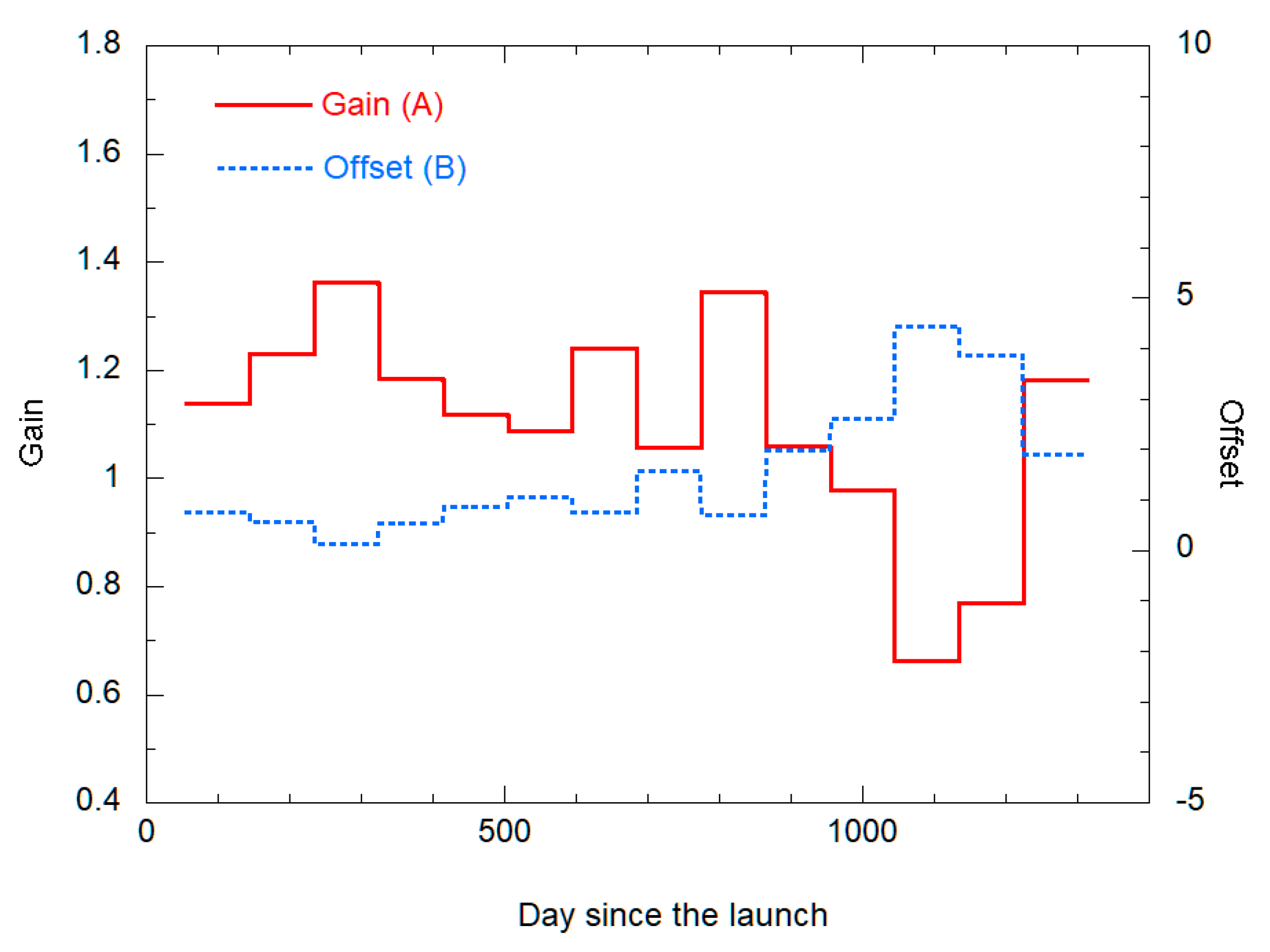
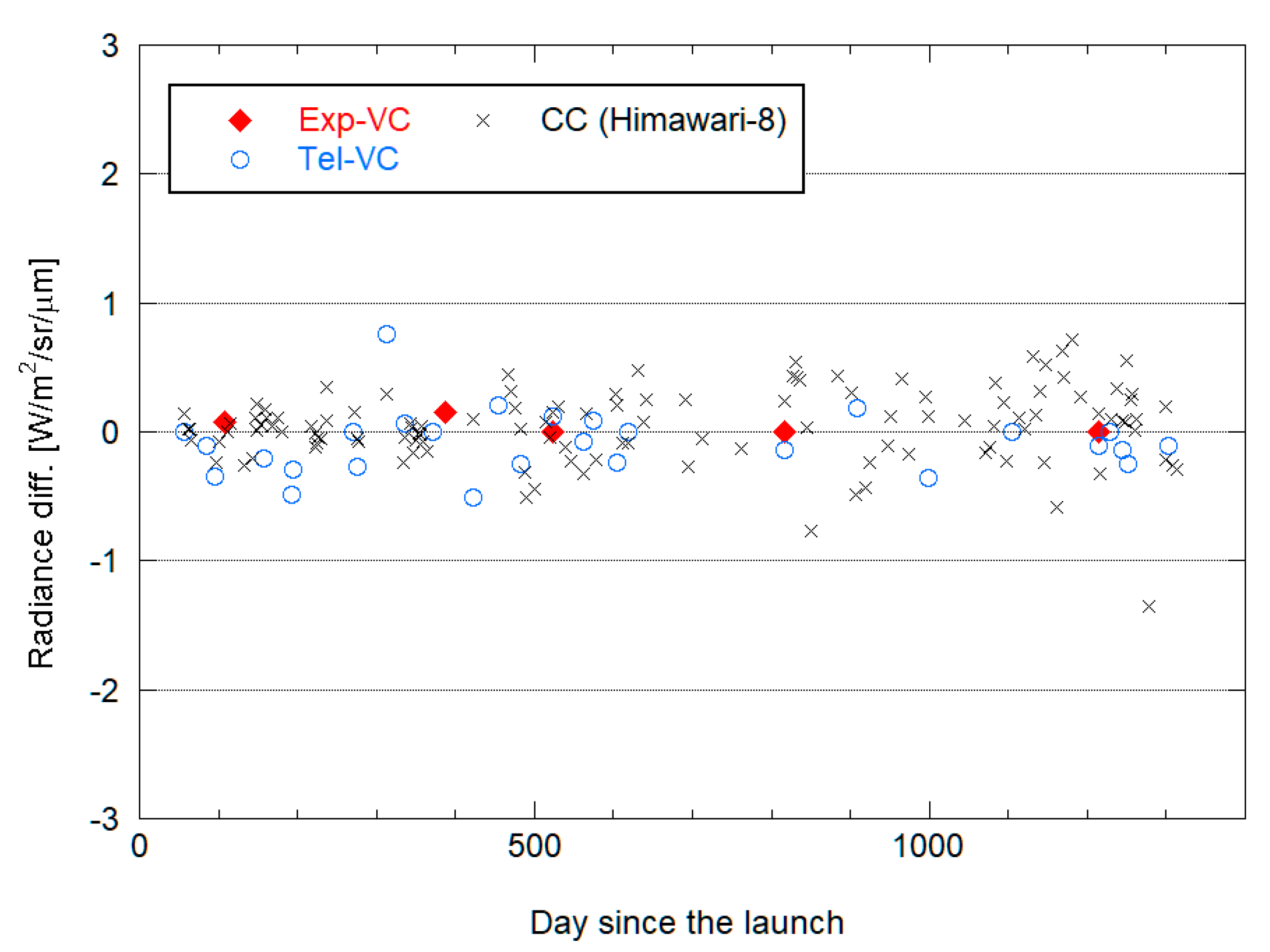
| Item | Specifications |
|---|---|
| Size | 110 mm × 180 mm × 230 mm |
| Weight | 3 kg |
| Detector | Uncooled infrared detector |
| Wavelength | 8 to 12 µm |
| Number of pixels | 640 × 480 |
| Ground resolution | <200 m @ 600 km (ALOS-2) <130 m @ 400 km (CALET) |
| Field of view | 12° × 9° |
| Exposed time | 33 ms |
| Dynamic range | 180 to 400 K |
| NEdT | 0.2 K @ 300 K |
| FPN | 0.3 K @ 300 K |
| Power consumption | <20 W |
| Temperature accuracy | 4 K (goal: 2 K @ 300 K) |
| Parameter Change | ALOS-2/CIRC | CALET/CIRC | |||
|---|---|---|---|---|---|
| Exp-VC | Tel-VC | Exp-VC | Tel-VC | ||
| Surface temp. | −1 K | −0.80 (0.05) | −0.76 (0.12) | −0.83 (0.02) | −0.80 (0.08) |
| +1 K | 0.81 (0.04) | 0.76 (0.12) | 0.83 (0.03) | 0.81 (0.08) | |
| Atmos. profile | AT: −1 K, RH: ×1.1 | −0.20 (0.08) | −0.26 (0.19) | −0.16 (0.04) | −0.19 (0.13) |
| AT: +1 K, RH: ×0.9 | 0.21 (0.08) | 0.27 (0.19) | 0.17 (0.03) | 0.20 (0.12) | |
| Method | Num of Data | RMSD in Radiance (W/m2/sr/µm) | RMSD in Temp at 300 K (K) |
|---|---|---|---|
| Exp-VC | 9 | 0.224 | 1.4 |
| Tel-VC | 80 | 0.318 | 2.0 |
| CC (MTSAT-2) | 19 | 0.292 | 1.9 |
| CC (Himawari-8) | 245 | 0.246 | 1.6 |
| CC (both) | 264 | 0.258 | 1.6 |
| Method | Num of Data | RMSD in Radiance (W/m2/sr/µm) | RMSD in Temp at 300 K (K) |
|---|---|---|---|
| Exp-VC | 5 | 0.078 | 0.5 |
| Tel-VC | 28 | 0.259 | 1.7 |
| CC (Himawari-8) | 123 | 0.292 | 1.9 |
© 2019 by the authors. Licensee MDPI, Basel, Switzerland. This article is an open access article distributed under the terms and conditions of the Creative Commons Attribution (CC BY) license (http://creativecommons.org/licenses/by/4.0/).
Share and Cite
Tonooka, H.; Sakai, M.; Kumeta, A.; Nakau, K. In-Flight Radiometric Calibration of Compact Infrared Camera (CIRC) Instruments Onboard ALOS-2 Satellite and International Space Station. Remote Sens. 2020, 12, 58. https://doi.org/10.3390/rs12010058
Tonooka H, Sakai M, Kumeta A, Nakau K. In-Flight Radiometric Calibration of Compact Infrared Camera (CIRC) Instruments Onboard ALOS-2 Satellite and International Space Station. Remote Sensing. 2020; 12(1):58. https://doi.org/10.3390/rs12010058
Chicago/Turabian StyleTonooka, Hideyuki, Michito Sakai, Ayaka Kumeta, and Koji Nakau. 2020. "In-Flight Radiometric Calibration of Compact Infrared Camera (CIRC) Instruments Onboard ALOS-2 Satellite and International Space Station" Remote Sensing 12, no. 1: 58. https://doi.org/10.3390/rs12010058
APA StyleTonooka, H., Sakai, M., Kumeta, A., & Nakau, K. (2020). In-Flight Radiometric Calibration of Compact Infrared Camera (CIRC) Instruments Onboard ALOS-2 Satellite and International Space Station. Remote Sensing, 12(1), 58. https://doi.org/10.3390/rs12010058




